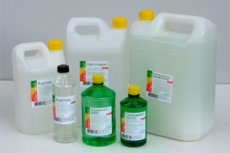Medical expert of the article
New publications
Solvent vapor poisoning
Last reviewed: 29.06.2025

All iLive content is medically reviewed or fact checked to ensure as much factual accuracy as possible.
We have strict sourcing guidelines and only link to reputable media sites, academic research institutions and, whenever possible, medically peer reviewed studies. Note that the numbers in parentheses ([1], [2], etc.) are clickable links to these studies.
If you feel that any of our content is inaccurate, out-of-date, or otherwise questionable, please select it and press Ctrl + Enter.

Solvent is a chemical substance used for degreasing surfaces, diluting varnishes and paints. Improper handling of this substance causes serious injury. The substance is highly toxic, volatile and evaporates easily. Inhalation of its vapors causes severe poisoning.
Symptoms of the solvent poisoning
The solvent enters the body in several ways:
- Through the stomach - when a liquid is swallowed, it is absorbed through the walls of the GI tract and enters the bloodstream. Through the blood, toxic substances spread throughout the body, penetrating the CNS, heart, soft tissues, internal organs. As soon as harmful substances get into the liver (the organ is responsible for cleaning the blood and the body from toxins), the victim has convulsions and other pathological symptoms.
- Through the lungs - inhalation of vapor carries toxins with the blood throughout the body. In a few minutes, painful symptoms develop. If the poisoning is mild, there is a headache, dizziness. If there are a lot of toxins, then there is a feeling of intoxication, hallucinations. Prolonged inhalation of vapors negatively affects the central nervous system, heart, brain. There is a risk of death.
- Through the skin - this type of injury is the result of handling a hazardous substance without personal protective equipment. Toxins penetrate into the bloodstream, adversely affecting all organs and systems.
Inhalation intoxication is manifested by vomiting, coughing, asphyxia. The victim develops headache, nausea, possible hallucinations. As soon as the toxins disperse to the organs, fainting and even death are possible.
Treatment of the solvent poisoning
The first thing that should be done to improve the patient's condition is to take him to fresh air, away from the source of poisoning and call an ambulance. Before the arrival of medics you should try to induce vomiting in the victim. Further treatment depends on the degree of intoxication and is determined by doctors.
Specialized treatment in a medical facility for solvent poisoning may include the following measures:
- Gastric lavage: Once the casualty is stabilized, gastric lavage may be necessary to remove residual solvent and prevent it from entering the bloodstream. This procedure is usually performed using a gastric sonde.
- Respiratory and Circulatory Support: The victim may require artificial ventilation (ventilator) and/or intravenous fluids to support respiration and circulation if the solvent has caused impairment of these bodily functions.
- Condition Monitoring: The victim will be continuously monitored with specialized medical devices to assess his or her breathing, heart rate, blood pressure and other important indicators.
- Treatment of complications: Steps may be taken to treat complications resulting from solvent poisoning, such as respiratory burns, cardiovascular dysfunction, and others.
- Detoxification: In some cases, detoxification procedures may be required to remove the solvent from the body. This may include administering medications or performing blood purification procedures such as hemodialysis.
- Maintenance of vital functions: It is important to ensure that the casualty maintains vital bodily functions throughout treatment and care.

